International Consulting
Water and Sanitation(Water quality and environmental conservation)
Mauritius
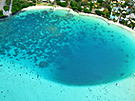 Aerial Photograph from Helicopter
Aerial Photograph from Helicopter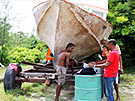 Questionnaire Survey in the Field
Questionnaire Survey in the Field
| Title | : | The Project for Capacity Development on Coastal Protection and Rehabilitation |
| Period | : | March 2012 – September 2014 |
| Funded by | : | JICA |
Mauritius is particularly vulnerable to climate change and has an increasingly serious problem with coastal erosion caused by natural disasters resulting from environmental changes and an increase of tourism-related structures and land development on steep slopes. Against this background, various climate change adaptation programs are being conducted in Mauritius mainly by the Japanese Government and the Africa Adaptation Programme (APP) under the United Nations Development Programme (UNDP), including this project. It is closely tied to another project by Kokusai Kogyo experts to assist Mauritius in mitigating landslide disasters, which is also related to APP.
This coastal protection project involves five components:
- 1. A baseline survey to identify coastal erosion sites
- 2. A coastal conservation plan for the main island of Mauritius is formulated; and priority sites for coastal protection and rehabilitation measures will be selected based on this plan.
- 3. The effectiveness of the coastal conservation plan is validated through demonstration projects.
- 4. The technical capacity of the staff in Ministry of Environment and Sustainable Development (MoESD) and other administrations is enhanced.
Lao People’s Democratic Republic
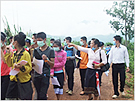 Observation tour to the final disposal site in Xayabouri
Observation tour to the final disposal site in Xayabouri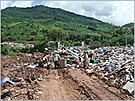 Typical scene of an access road to a final disposal site in the rainy season, when poor road conditions force waste trucks to dump waste on the road.
Typical scene of an access road to a final disposal site in the rainy season, when poor road conditions force waste trucks to dump waste on the road.
| Title | : | Environmental Management Component of Laos Pilot Program for Narrowing Development Gap towards ASEAN Integration |
| Period | : | September 2011 – October 2015 |
| Funded by | : | JICA |
Laos Pilot Program for Narrowing the Development Gap towards ASEAN Integration is a tripartite cooperation project whereby the ASEAN Secretariat, JICA and the Government of Laos work together to narrow the development gap towards ASEAN integration. Under the core concept of “Clean, Green, Beautiful Laos”, it has three components, namely, promotion of tourism, promotion of good agricultural practices, and environmental management, and it is the last component that Kokusai Kogyo has been comissioned.
The project goal is the promotion of environmental sustainability. The Environmental Sustainable City Guideline, drafted in the first year of the project, is one of the major achievements of the mutual commitment to the goal of the Laotian counterpart and Kokusai Kogyo’s expert team. Following the guideline, the project is currently at the stage of implementing actual improvements in three pilot cities, Vientiane Capital, Luang Prabang and Xayabouri, taking solid waste management as a model sector. Pilot projects will cover various subjects from engineering works to community-based activities, from which the counterparts will experience “learning-by-doing” for future self-sustained operation.
Tuvalu
 Causeway in northern Fongafale Island, suspected of obstructing sediment transport into the lagoon, vital for natural beach nourishment
Causeway in northern Fongafale Island, suspected of obstructing sediment transport into the lagoon, vital for natural beach nourishment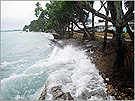 Coastal erosion in Tuvalu
Coastal erosion in Tuvalu
| Title | : | Study for Assessment of Ecosystem, Coastal Erosion and Protection/Rehabilitation of Damaged Area |
| Period | : | August 2009 – February 2011 |
| Funded by | : | JICA |
Tuvalu is a country consisting of coral reef islands, mostly formed of coral, shell, and foram sand deposits. It has attracted international attention as being in danger of submerging, because most of its landmass is low-lying atoll only 1 to 3 meters above sea level. To ensure the island’s long-term sustainability, it is vital to clarify the underlying causes of submergance including the deterioration of sand production/movement/deposition mechanisms and sea level rise due to global warming. Accordingly, the government of Tuvalu and the government of Japan agreed to implement, on one hand, an international science and technology cooperation project to increase the resilience of Tuvalu coast from a long-term perspective, and on the other hand, this development planning study to propose short-term coastal erosion countermeasures.
In the study, Kokusai Kogyo studied the present situation by a comprehensive review of past studies and field surveys of a range of aspects such as sea currents, water quality, sea bottom sediments, coastal ecosystem and socio-economic conditions, and produced a basic plan for coastal protection and rehabilitation. We divided the study area into seven sub-areas and proposed both hard and soft countermeasures depending on the degree of urgency of each sub-area. Furthermore, in light of Tuvalu’s particular social structure, we held public hearings for Fale Caupule (decision making body of communities), women’s groups, Masaua (all residents), youth groups, and fishermen to further their understanding of and to gain their input on the basic plan.
We also carried out feasibility studies for two pilot areas with the highest priority for coastal erosion measures, and gave every assistance so as to ensure their smooth and rapid implementation.
Further details can be found here.
Vietnam
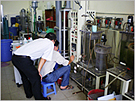 Technical instruction of water quality testing (Vietnam)
Technical instruction of water quality testing (Vietnam)
| Title | : | Enhancing Capacity of Vietnamese Academy of Science and Technology in Water Environment Protection, Phase II |
| Period | : | December 2007 – November 2011 |
| Funded by | : | JICA |
Rapid economic development and urbanization in Vietnam have been degrading water quality in rivers, lakes, canals and the sea. The government of Vietnam amended its Environment Protection Law issued in 1994 and intends to enhance its environment-related legislation. However, its technical capability when it comes to water quality monitoring and analysis, the foundation of policy development, is not sufficient and needs upgrading.
Under such circumstances, JICA carried out a technical assistance project, “Enhancing Capacity of Vietnamese Academy of Science and Technology (VAST) in Water Environment Protection”, with the Institute of Environmental Technology (IET) of VAST as a counterpart, and technical capacity such as water quality monitoring and wastewater treatment was developed. In order to fully utilize such project outcomes and to further upgrade the technological levels, Phase II of the project was started and the expert team of Kokusai Kogyo was commissioned.
As a result of the project, the technology of IET in water quality monitoring and wastewater treatment was further developed. IET’s water quality analysis capability increased dramatically, especially in microscale analysis using both gas and liquid chromatograph tandem mass spectrometry. We also assisted the capacity development of IET’s branches in Danang and Ho Chi Minh City to strengthen its nationwide research network. Moreover, its environmental advisory function and policy implementation capacity were significantly improved as seen in the preparation of training materials for pollution control managers and the development of simplified COD meters.
Bangladesh
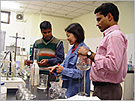 Technical instruction of waste water treatment technology
Technical instruction of waste water treatment technology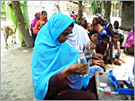 A city official testing water quality
A city official testing water quality
| Title | : | The Project for Strengthening of Water Examination |
| Period | : | February 2004 – March 2006, March 2009 – February 2012 |
| Funded by | : | Japanese Grant Aid, Technical Assistance by JICA |
The contamination of groundwater with arsenic has been spreading in Bangladesh. It is reported that about 20 million people are at risk of arsenic poisoning. A potable water quality control system was, however, not well developed and the government of Bangladesh requested the government of Japan for grant aid to strengthen the system.
Kokusai Kogyo carried out a basic design study, which identified the need for the construction of a central laboratory and for refurbishment of two local laboratories, as well as procurement of laboratory equipment for each laboratory. The central laboratory was designed so as to fulfill the responsibility for the training of laboratory technicians, quality control of the local laboratories and assistance for the local laboratories in terms of equipment operation and maintenance.
Kokusai Kogyo also supervised the construction of the central laboratory and the procurement of equipment, and provided further technical training on laboratory management, equipment operation and maintenance, water quality analysis and data quality control. The central laboratory was successfully handed over to the Department of Public Health Engineering, Ministry of Local Government, Rural Development and Cooperatives in March 2006.
Kokusai Kogyo’s team was again chosen to undertake a technical assistance project starting in March 2009. The objective of the project was to strengthen the water examination system by improving technical capability at the central laboratory and 12 local laboratories within three years. Our consultants worked with the counterparts to further their understanding and competency of standard operation procedures of different parameters and to improve laboratory management.
Sort by region
| Geospatial Information | Forestry | Disaster Risk Reduction | Energy |
| Water and Sanitation | Agriculture | Urban Development | Others |
Sort by sector
| Asia | Middle East | Europe | Africa |
| South and Central America | Oceania | Worldwide |

